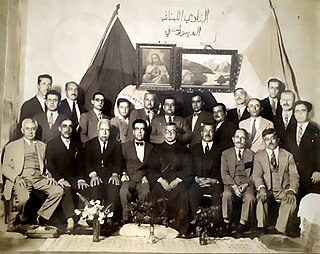
Arab diaspora is a term that refers to descendants of the Arab emigrants who, voluntarily or as forcibly, migrated from their native lands to non-Arab countries, primarily in the Americas, Europe, Southeast Asia, and West Africa.
Asian Latin Americans are Latin Americans of Asian descent. Asian immigrants to Latin America have largely been from East Asia or West Asia. Historically, Asians in Latin America have a centuries-long history in the region, starting with Filipinos in the 16th century. The peak of Asian immigration occurred in the 19th and 20th centuries. There are currently more than four million Asian Latin Americans, nearly 1% of Latin America's population. Chinese, Japanese, and Lebanese are the largest Asian ancestries; other major ethnic groups include Filipinos, Syrians, Koreans and Indians, many of whom are Indo-Caribbean and came from neighboring countries in the Caribbean and the Guianas. Brazil is home to the largest population of East Asian descent, estimated at 2.08 million. The country is also home to a large percentage of West Asian descendants. With as much as 5% of their population having some degree of Chinese ancestry, Peru and Mexico have the highest ratio of any country for East Asian descent. Though the most recent official census, which relied on self-identification, gave a much lower percentage.

Arab Canadians come from all of the countries of the Arab world. According to the 2021 Census, there were 690,000 Canadians, or 1.9%, who claimed Arab ancestry. According to the 2011 census there were 380,620 Canadians who claimed full or partial ancestry from an Arabic-speaking country. The large majority of the Canadians of Arab origin population live in either Ontario or Quebec.
Arab traders have been visiting the Philippines for about 2,000 years, playing a prominent role in the trade networks of the time. They used Southeast Asia for stopovers and trading posts. Since the 14th century, Arab travelers such as Makhdun Karim is known to have reached the Philippines and brought Islam to the region. They moved from the southern islands such as Mindanao and traveled towards the north and converted the Filipinos to Islam, many of these early Arabs married Filipina women.

Arab Brazilians are Brazilian citizens of Arab ethnic, cultural, linguistic heritage and identity. The majority of Arab Brazilians trace their origin to the Levantine region of the Arab World, known in Arabic as Bilad al-Sham, primarily from Lebanon and Syria, as well as Palestine. Christians are the majority of the Arab Brazillians. The first Syrians and Lebanese arrived in São Paulo around 1880. It is not known exactly when, although the Syrians and Lebanese say that in 1885 there was a small core of peddlers working in the market square. By 1920, the census listed 50,246 Syrians and Lebanese in Brazil, 38.4% (2/5) of these in the state of São Paulo. The 1940 census enumerated 48,614 Syrians, Lebanese and other related groups with a decrease of approximately 1647 people. As immigration almost ceased after 1929 and the colony aged, it is surprising that the decline was not even greater. The trend of the period between 1920 and 1940 was the continuous concentration of Syrians and Lebanese in São Paulo. Almost half (49.3%) of Syrians and Lebanese residents in Brazil lived in São Paulo.
Arab Mexicans are Mexican citizens of Arab ethnic lineage, who identify themselves as Arab. Some of Mexico's Arabs are of Lebanese.

Lebanese Brazilians, are Brazilians of full or partial Lebanese ancestry, including Lebanese-born immigrants to Brazil. According to the Brazilian Institute of Geography and Statistics, they form some of the largest Asian communities in the country, along with other West Asian and East Asian descendants.
Arab Chileans are Chileans from predominantly Arab ancestry. People from the Arab world arrived in Chile as early as the mid-19th century. Historically, the Arabs of Chile were called Turks, Moors, Syrians, Lebanese, or Palestinians.
Arab Australians refers to Australian citizens or residents with ancestry from the Middle East and North Africa, regardless of their ethnic origins. Many are not ethnically Arab but numerous groups who include Arabs, Kurds, Copts, Assyrians, Berbers and others. The majority are Christian by faith with minorities being Muslim, Druze, Yazidi and other faiths.
White Colombians are the Colombian descendants of European and Middle Eastern people living in Colombia. According to the 2018 census, 87.58% of Colombians do not identify with any ethnic group, thus being either white or mestizo, which are not categorized separately.

Haitians are the citizens and nationals of Haiti. The Haitian people have their origins in Central and West Africa with the most spoken language being the French based Haitian Creole. The larger Haitian diaspora includes individuals that trace ancestry to Haiti and self-identify as Haitian but are not necessarily Haitian by citizenship. The United States and the Dominican Republic have the largest Haitian populations in the world after Haiti.
Syrian Haitians are Haitian of Syrian descent or a Syrian with Haitian citizenship. A small Syrian community exists in Haiti.

The Detroit metropolitan area has one of the largest concentrations of people of Middle Eastern origin, including Arabs and Chaldo-Assyrians in the United States. As of 2007 about 300,000 people in Southeast Michigan traced their descent from the Middle East. Dearborn's sizeable Arab community consists largely of Lebanese people who immigrated for jobs in the auto industry in the 1920s, and of more recent Yemenis and Iraqis. In 2010 the four Metro Detroit counties had at least 200,000 people of Middle Eastern origin. Bobby Ghosh of TIME said that some estimates gave much larger numbers. From 1990 to 2000 the percentage of people speaking Arabic in the home increased by 106% in Wayne County, 99.5% in Macomb County, and 41% in Oakland County.

The Palestinian diaspora, part of the wider Arab diaspora, are Palestinian people living outside the region of Palestine.
Lebanese Haitians are Haitians of Lebanese descent, one of several groups of Arab Haitians. Their history dates back to the late 1800s, when many individuals left Lebanon for the Americas, including Haiti. They are active in a variety of industries, including retail and telecommunications. As of 2010, their population was estimated at 12,000. As a minority with a position of relative power in the Haitian economy, they have faced ethnic discrimination, notably encouraged by gang leader Jimmy Chérizier.
Palestinian Haitians are Haitians of Palestinian descent, or Palestinians with Haitian citizenship.
Arab Uruguayans are residents or citizens of Uruguay of Arab ethnicity, whose ancestry predominantly traces back to any of various waves of immigrants from the Arab world, especially Lebanon and Syria.
T-Vice is a Haitian compas band currently based in Miami, Florida. The group has performed throughout the world, most notably in cities of Miami, New York City, Chicago, Toronto, Paris and throughout the Caribbean through various concerts, carnivals, and festivals.

Arab immigration to the Republic of Honduras began in the 19th century with the liberal reforms of President Marco Aurelio Soto (1876–1883), who saw immigration as a determining factor in the development of capitalism in Central America, and sought to establish an attractive environment for foreign investment. The largest Arab community in Honduras is the people of Palestinian descent, the majority of whom (95%) are Christian. The approximate population of Honduran Arabs is more than 300,000 people, around 280,000 Palestinians and 20,000 Lebanese, estimates place the Muslim population at about 11,000.






